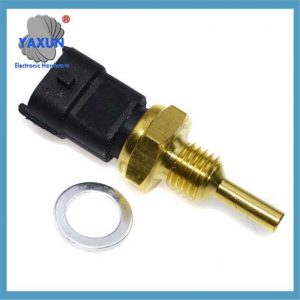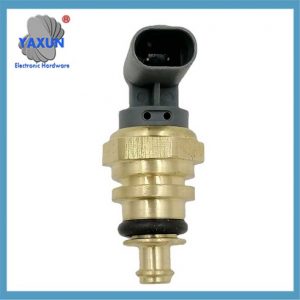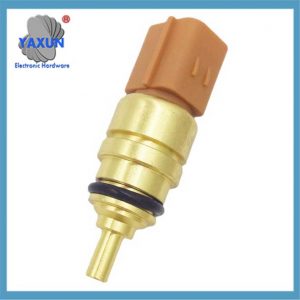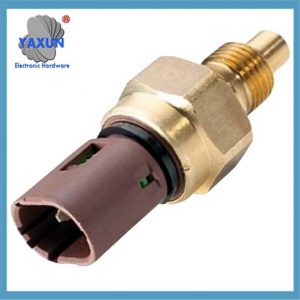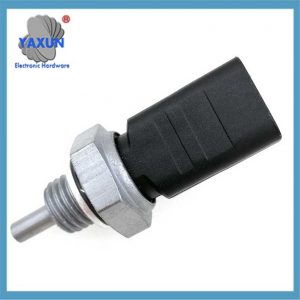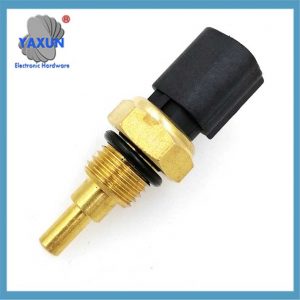자동차 엔진 수온 센서는 물의 온도 또는 액체 냉각수를 측정합니다.. 이 센서는 다양한 응용 분야에서 사용됩니다, 자동차 엔진을 포함하여, 수냉 시스템, 산업 공정, 온도를 모니터링하고 조절합니다. 물 또는 기타 액체의 온도를 측정하기 위해 다양한 산업 공정에 사용, 종종 데이터 로거 또는 제어 시스템과 함께.
The main function of the water temperature sensor is to monitor the engine coolant temperature. Its core component is a negative temperature coefficient thermistor (NTC). The resistance value of this material decreases exponentially when the temperature rises, such as about 2.5kΩ at 20℃ and about 0.3kΩ at 80℃. This feature allows it to convert temperature changes into electrical signals.
Regarding the installation location, most sensors (65%) are installed on the water jacket of the engine cylinder block/cylinder head. Some are also near the cylinder head thermostat (22%) or the radiator outlet (13%). This design is to directly contact the coolant to ensure accurate temperature measurement.
The role of the sensor is critical: at low temperatures, the ECU will increase the injection volume by 30% to help cold start; at high temperatures, the injection base amount will be corrected. It will also affect the ignition system, such as advancing the ignition angle by 8-12° at -20℃ and delaying it by 4-6° at 100℃ to prevent explosion. 게다가, idle speed control also depends on it, and the speed will be raised to 1200-1500rpm at low temperatures.
In terms of fault manifestation, common problems include difficulty in cold start, 불안정한 유휴 속도, abnormal fan operation, 등. There are several ways to diagnose: use a multimeter to measure the power supply voltage (normal 5V or 12V), read the data stream (normal water temperature signal is about 95℃), or measure the resistance value after heating (should be 1.4-1.9kΩ at 30℃).
The automobile engine water temperature sensor is the core monitoring element of the engine management system. Its function, 구조, working principle and fault manifestation are as follows:
🔧 1. Structure and working principle
Core element: Adopting Negative temperature coefficient thermistor (NTC), the resistance value decreases exponentially when the temperature rises (such as about 2.5kΩ at 20℃, and drops to 0.3kΩ at 80℃).
signal 전환 ign: Convert the coolant temperature change into an electrical signal (usually 1.3V-3.8V linear change) and transmit it to the engine control unit (ECU).
율 설치 위치 st:
엔진 실린더 블록/실린더 헤드 워터 재킷 (회계 65%);
Coolant shunt pipe or near the thermostat.
Types of Water Temperature Sensors:
Engine Coolant Temperature Sensors (ECTS):
Found in vehicles, these sensors monitor the temperature of the engine coolant, providing feedback to the engine control unit (ECU) for optimal fuel injection and ignition timing.
Water Cooling System Sensors:
Used in custom PC water cooling loops or industrial cooling systems to monitor the temperature of the coolant and ensure proper heat dissipation.
Examples of Applications:
자동차: Monitoring engine coolant temperature to optimize engine performance and prevent overheating.
Water Cooling: Maintaining optimal temperatures in PC water cooling loops for stable system performance.
산업 공정: Monitoring temperatures in manufacturing processes, HVAC 시스템, and other applications involving liquids.
Aquaculture: Monitoring water temperature for optimal fish or plant growth.
Oceanography: Measuring water temperature at various depths for research and monitoring.
⚙️ 2. Core functions
The water temperature sensor provides real-time temperature data to the ECU for dynamically regulating engine operation:
Fuel Control: Low temperature (<86℃): Increase the injection amount (최대 +30% 보상) to improve cold start performance;
High temperature: Reduce the injection amount and optimize the air-fuel ratio.
Ignition adjustment: Increase the ignition advance angle at low temperatures (8–12° at -20℃), and delay at high temperatures (4–6° at 100℃) to prevent explosion.
Idle and heat dissipation control: Increase the idle speed to 1200–1500rpm at low temperatures;
Trigger the start and stop of the cooling fan (high-speed operation at high temperatures).
Instrument display: Drive the water temperature gauge pointer, 90℃ is the ideal working temperature.
Key Features:
Measuring Range: The range of temperatures the sensor can accurately measure.
정확성: How closely the sensor’s readings match the actual temperature.
응답 시간: The speed at which the sensor reacts to temperature changes.
Durability: The sensor’s ability to withstand environmental conditions (예를 들어, 물, temperature extremes).
장착 스타일: How the sensor is attached to the system (예를 들어, 담금, thread type).
⚠️ III. Fault manifestation and diagnosis
(1) Typical fault symptoms:
Difficulty starting a cold car, idling fluctuations or abnormal increase;
Abnormal water temperature gauge indication (no movement, false high or out of range);
The cooling fan keeps running or does not start at all;
Increased fuel consumption and weak acceleration.
(2) Detection method:
IV. Fault impact mechanism Signal distortion: ECU misjudges the temperature (such as receiving a fixed signal of -40℃ or 130℃), resulting in incorrect injection/ignition strategy;
Line fault: Open circuit/short circuit blocks signal transmission, causing mixture imbalance;
Component aging: Thermistor characteristic drift or coolant corrosion causes reduced accuracy.
💎 요약
The water temperature sensor is like the “온도계” of the engine. Its accuracy is directly related to fuel economy, emission control and mechanical life. Regularly checking the resistance characteristics and signal stability (especially the comparison between hot and cold states) can effectively prevent systemic failures caused by sensor failure.
 English
English Afrikaans
Afrikaans العربية
العربية বাংলা
বাংলা bosanski jezik
bosanski jezik Български
Български Català
Català 粤语
粤语 中文(简体)
中文(简体) 中文(漢字)
中文(漢字) Hrvatski
Hrvatski Čeština
Čeština Nederlands
Nederlands Eesti keel
Eesti keel Suomi
Suomi Français
Français Deutsch
Deutsch Ελληνικά
Ελληνικά हिन्दी; हिंदी
हिन्दी; हिंदी Magyar
Magyar Bahasa Indonesia
Bahasa Indonesia Italiano
Italiano 日本語
日本語 한국어
한국어 Latviešu valoda
Latviešu valoda Lietuvių kalba
Lietuvių kalba македонски јазик
македонски јазик Bahasa Melayu
Bahasa Melayu Norsk
Norsk پارسی
پارسی Polski
Polski Português
Português Română
Română Русский
Русский Cрпски језик
Cрпски језик Slovenčina
Slovenčina Slovenščina
Slovenščina Español
Español Svenska
Svenska ภาษาไทย
ภาษาไทย Türkçe
Türkçe Українська
Українська اردو
اردو Tiếng Việt
Tiếng Việt

